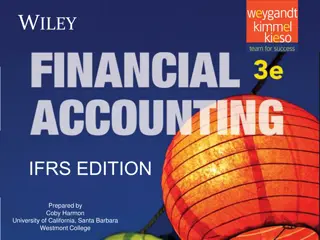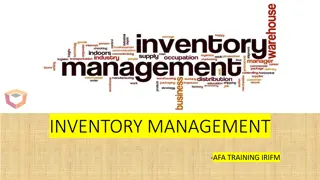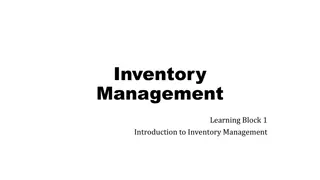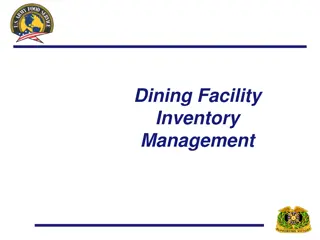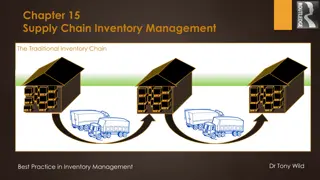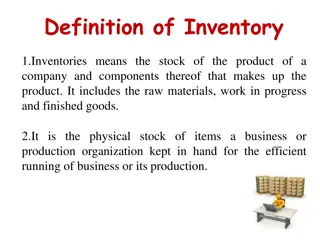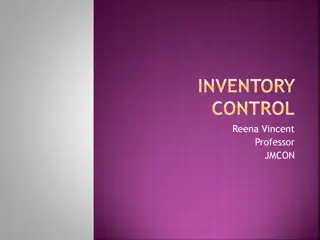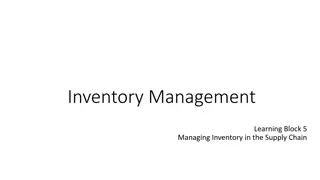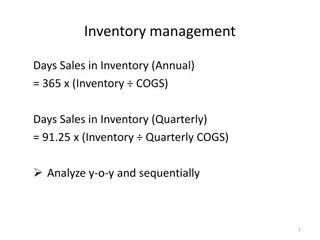Understanding Inventory Management in Financial Accounting
Explore the intricacies of inventory management in financial accounting through discussions on classifying inventory, determining inventory quantities, and the impact of inventory errors. Learn about inventory cost flow methods, the lower-of-cost-or-net realizable value basis, and the financial effects of inventory cost flow assumptions. Gain insights into the presentation and analysis of inventory to enhance your financial knowledge.
- Inventory Management
- Financial Accounting
- Inventory Classification
- Cost Flow Methods
- Inventory Errors
Download Presentation

Please find below an Image/Link to download the presentation.
The content on the website is provided AS IS for your information and personal use only. It may not be sold, licensed, or shared on other websites without obtaining consent from the author. Download presentation by click this link. If you encounter any issues during the download, it is possible that the publisher has removed the file from their server.
E N D
Presentation Transcript
WILEY IFRS EDITION IFRS EDITION Prepared by Coby Harmon University of California, Santa Barbara Westmont College 6-1 6-1
PREVIEW OF CHAPTER 6 Financial Accounting IFRS 3rd Edition Weygandt Kimmel Kieso 6-2 6-2
CHAPTER 6 LEARNING OBJECTIVES Inventories After studying this chapter, you should be able to: 1. Discuss how to classify and determine inventory. 2. Explain the accounting for inventories and apply the inventory cost flow methods. 3. Explain the financial effects of the inventory cost flow assumptions. 4. Explain the lower-of-cost-or-net realizable value basis of accounting for inventories. 5. Indicate the effects of inventory errors on the financial statements. 6. Discuss the presentation and analysis of inventory. 6-3
Classifying and Determining Inventory Learning Objective 1 Discuss how to classify and determine inventory. Classifying Inventory Manufacturing Company Merchandising Company Three Classifications: One Classification: Raw Materials Inventory Work in Process HELPFUL HINT Regardless of the classification, companies report all inventories under Current Assets on the statement of financial position. Finished Goods LO 1 6-4 6-4
ACCOUNTING ACROSS THE ORGANIZATION A Big Hiccup JIT can save a company a lot of money, but it isn t without risk. An unexpected disruption in the supply chain can cost a company a lot of money. Japanese automakers experienced just such a disruption when a 6.8-magnitude earthquake caused major damage to the company that produces 50% of their piston rings. The rings themselves cost only $1.50, but you cannot make a car without them. No other supplier could quickly begin producing sufficient quantities of the rings to match the desired specifications. As a result, the automakers were forced to shut down production for a few days a loss of tens of thousands of cars. Source: Amy Chozick, A Key Strategy of Japan s Car Makers Backfires, Wall Street Journal (July 20, 2007). LO 1 6-5
Determining Inventory Quantities Physical Inventory taken for two reasons: Perpetual System 1. Check accuracy of inventory records. 2. Determine amount of inventory lost due to wasted raw materials, shoplifting, or employee theft. Periodic System 1. Determine the inventory on hand. 2. Determine the cost of goods sold for the period. LO 1 6-6 6-6
Determining Inventory Quantities TAKING A PHYSICAL INVENTORY Involves counting, weighing, or measuring each kind of inventory on hand. Companies often take inventory when the business is closed or business is slow. at the end of the accounting period. LO 1 6-7 6-7
ETHICS INSIGHT Falsifying Inventory to Boost Income Managers at a women s apparel maker were convicted of falsifying inventory records to boost net income and consequently to boost management bonuses. In another case, executives at an electronics manufacturer were accused of defrauding lenders by manipulating inventory records. The indictment said the company classified defective goods as new or refurbished and claimed that it owned certain shipments from overseas suppliers when, in fact, the company either did not own the shipments or the shipments did not exist. LO 1 6-8
Determining Inventory Quantities DETERMINING OWNERSHIP OF GOODS GOODS IN TRANSIT Purchased goods not yet received. Sold goods not yet delivered. Goods in transit should be included in the inventory of the company that has legal title to the goods. Legal title is determined by the terms of sale. LO 1 6-9 6-9
DETERMINING OWNERSHIP OF GOODS GOODS IN TRANSIT Illustration 6-2 Terms of sale Ownership of the goods passes to the buyer when the public carrier accepts the goods from the seller. Ownership of the goods remains with the seller until the goods reach the buyer. LO 1 6-10 6-10
Determining Ownership of Goods Question Goods in transit should be included in the inventory of the buyer when the: a. public carrier accepts the goods from the seller. b. goods reach the buyer. c. terms of sale are FOB destination. d. terms of sale are FOB shipping point. LO 1 6-11 6-11
Determining Ownership of Goods CONSIGNED GOODS To hold the goods of other parties and try to sell the goods for them for a fee, but without taking ownership of the goods. Many car, boat, and antique dealers sell goods on consignment, why? LO 1 6-12 6-12
ANATOMY OF A FRAUD Ted Nickerson, CEO of clock manufacturer Dally Industries, was feared by all of his employees. Ted also had expensive tastes. To support this habit, Ted took out large loans, which he collateralized with his ordinary shares of Dally Industries. If the price of Dally s shares fell, he was required to provide the bank with more ordinary shares. To achieve target net income figures and thus maintain the share price, Ted coerced employees in the company to alter inventory figures. Inventory quantities were manipulated by changing the amounts on inventory control tags after the year-end physical inventory count. For example, if a tag said there were 20 units of a particular item, the tag was changed to 220. Similarly, the unit costs that were used to determine the value of ending inventory were increased from, for example, $125 per unit to $1,250. Both of these fraudulent changes had the effect of increasing the amount of reported ending inventory. This reduced cost of goods sold and increased net income. Total take: $245,000 The Missing Control Independent internal verification. The inventory records should have been spot-checked periodically, verifying that the number of units agreed with the amount on hand and that the unit costs agreed with vendor price sheets. LO 1 6-13
DO IT! > Deng Yaping Company completed its inventory count. It arrived at a total inventory value of 200,000. You have been given the information listed below. Discuss how this information affects the reported cost of inventory. 1. Deng Yaping included in the inventory goods held on consignment for Falls Co., costing 15,000. 2. The company did not include in the count purchased goods of 10,000, which were in transit (terms: FOB shipping point). 3. The company did not include in the count inventory that had been sold with a cost of 12,000, which was in transit (terms: FOB shipping point). Solution 1. Goods of 15,000 held on consignment should be deducted from the inventory count. 2. The goods of 10,000 purchased FOB shipping point should be added to the inventory count. 3. Item 3 was treated correctly. ( 200,000 - 15,000 + 10,000). Inventory should be 195,000 LO 1 6-14 6-14









